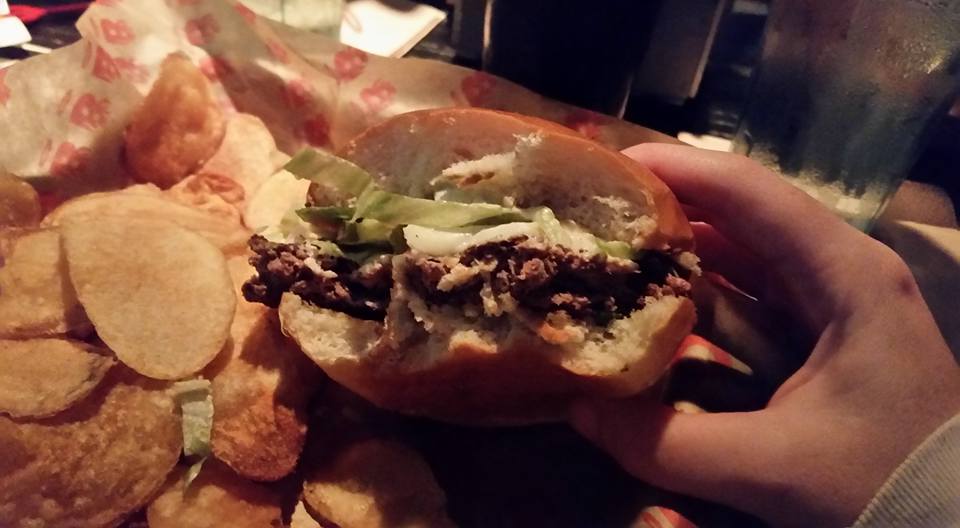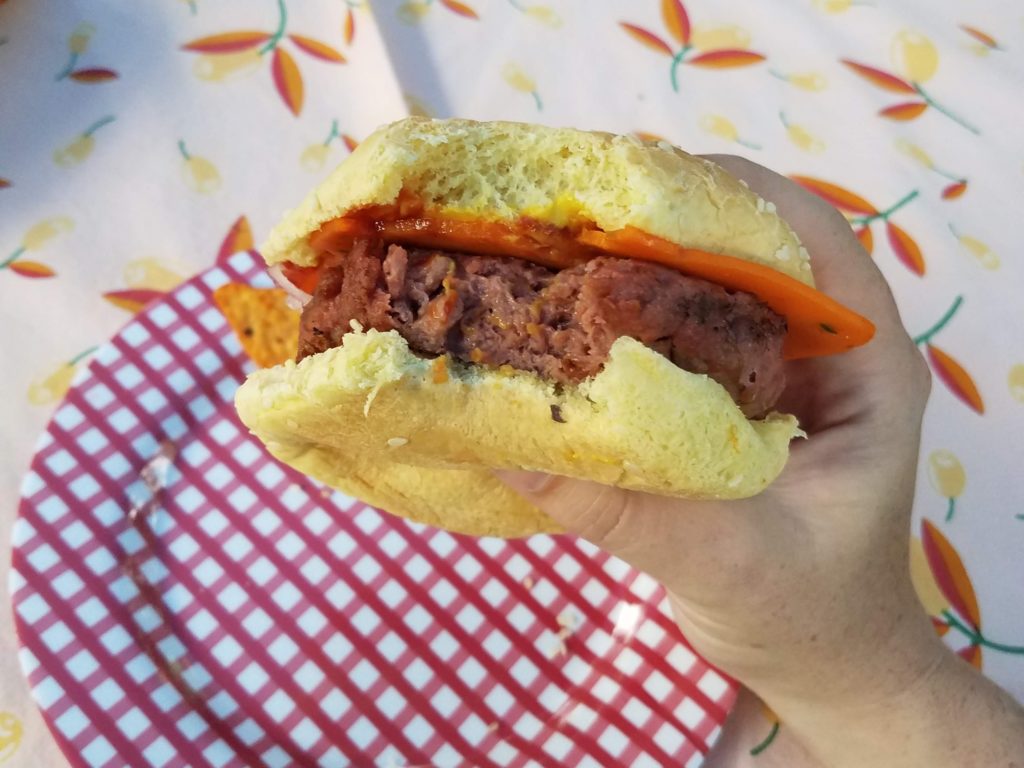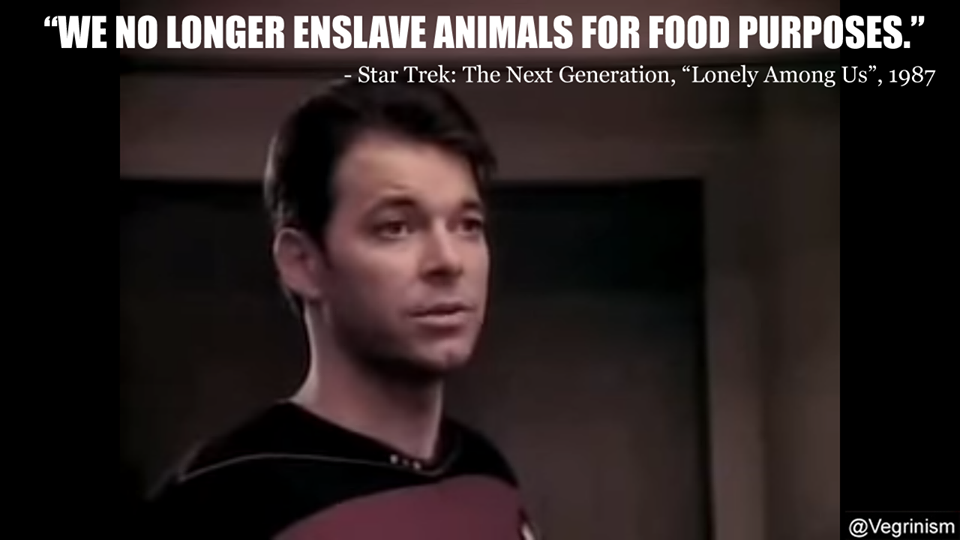Part 1 – Burger Overview
I will start this post with the assurance that I do not tell other people what they should or should not eat (except for veal – no one should eat that.) My choice to be vegetarian is mine, and I have my own reasons. It is a personal decision, and not one I can make for anyone else. This is a no-preaching zone, and I intend to present only facts, letting you decide what you want to put in your stomach.
Having been vegetarian for about half my life, I fancy myself to be a bit of a connoisseur when it comes to meatless meat dishes. I’ve exercised my American privilege of going to the grocery store and purchasing numerous brands of plant-based meat alternatives over the years (Morningstar, Gardenburger, Quorn, and Upton’s Naturals to name a few). I’ve also had the incredible fortune to experience amazing vegetarian food abroad – most notably the novelty of mock-meat while traveling to Buddhist temples in China.
Over the past year or so, a new wave of meatless burgers has taken the country by storm. I had tried the Impossible Burger when it first came to Pittsburgh in 2017, and I really enjoyed it. I particularly liked that it had the feel of a burger without quite the taste of a burger. It was good, but I never would have confused it for beef. (For the record, I never liked the taste of beef when I was a kid, and when I gave it up for good in high school, I never regretted my decision or missed it.)
In just the past week, I had the opportunity to try both the Beyond Burger at a cookout and the Impossible Whopper from Burger King for lunch at work. With all of my raving on social media about these new and different options, I’ve gotten a lot of questions from both meat eaters and vegetarians – some of which I could answer, and some of which I couldn’t. I figured that called for some research and writing on the subject…

Burger Basics: Impossible
Impossible Foods was first on the scene with their burger in 2016 and launched a new formulation in April 2019 that was designed to contain no wheat, have 30% less sodium, 40% less saturated fat, and the same amount of protein as 80/20 ground beef. (And yes I had to ask my husband what “80/20” means.)
The new and improved Impossible Burger (the only one you can get in restaurants now) contains the following ingredients: Water, Soy Protein Concentrate, Coconut Oil, Sunflower Oil, Natural Flavors, 2% or less of: Potato Protein, Methylcellulose, Yeast Extract, Cultured Dextrose, Food Starch Modified, Soy Leghemoglobin, Salt, Soy Protein Isolate, Mixed Tocopherols (Vitamin E), Zinc Gluconate, Thiamine Hydrochloride (Vitamin B1), Sodium Ascorbate (Vitamin C), Niacin, Pyridoxine Hydrochloride (Vitamin B6), Riboflavin (Vitamin B2), Vitamin B12.[1]
The real technological advance with these burgers is the use of a plant-based hemoglobin called heme – this is the component that imparts meaty flavor to food and also makes the burger “bleed.” Basically, the “meat” is red and loose when it’s raw, like beef. When it’s cooked, it turns brown and solidifies, like beef. I personally have eaten Impossible Burgers that are rare and others that are well done, and they mimic beef surprisingly well, in that well-done is dry and gross, and rare is moist, juicy, and flavorful. (I’ve also had to explain this to servers at more than one restaurant: yes, for these burgers, rare vs. well is an important distinction.)

The full process of creating the heme is described on Impossible Foods’ website, but in short, heme is manufactured by engineering yeast to include a gene for plant-based hemoglobin, derived from soy. It would be economically prohibitive to pull it from the roots of the soy plant, so they needed a method that was easier to propagate. Yeast is a lot easier to grow and a lot more prolific than soy plants, so they ultimately inserted the gene from the soy into a yeast strain and in turn harvested that.[2]
Yes, you read that correctly: they genetically engineered the yeast for the taste they wanted. According to Impossible Foods, vegetable rennet (used in cheese-making as a vegetarian alternative to animal rennet) is actually made in the same way. I have never heard of anyone objecting to consuming vegetable rennet, but I do know people who do not eat Impossible Burgers because they contain GMOs, which heme – by definition – is. Impossible Foods maintains that their soy-based heme is safe, as indicated by rigorous testing on rats. The ironic result from this fact is that many vegans will not eat the Impossible Burger (designed to promote plant-based diets) because of the animal testing that took place after specific questions posed by the FDA.
According to animal advocacy sites like PETA, Impossible Foods was under no legal obligation to perform tests on the rats,[3] which is technically true, assuming they didn’t care about getting FDA approval for a burger they intended to take mainstream. The main ingredient in question, heme, was “generally recognized as safe” (or “GRAS,” an actual technical term) according to federal food safety regulations before any animal testing was conducted. After the FDA posed follow-up questions from the previously-conducted non-animal testing, Impossible Foods performed industry-standard rat-feeding tests to demonstrate the safety of the ingredient. Impossible Foods’ CEO Pat Brown, in an open letter to consumers, discussed his ethical dilemma and explained how he essentially had to weigh the lives of 188 rats against the future exploitation of potentially billions of cows.[4] He stated specifically that “avoiding the dilemma was not an option. We hope we will never have to face such a choice again, but choosing the option that advances the greater good is more important to us than ideological purity.”[5]
I am not saying Brown’s decision is right or wrong – that is a matter of moral objectivism. Nor am I saying that the vegans who boycott the burger are wrong – that is a matter of moral absolutism. To me, vegetarianism has always been a personal choice – one to be decided based on individual ideals and not to be inflicted on others. It is up to you to decide if Brown made the right call or not, and if you are willing to eat the Impossible Burger in the future.

Burger Basics: Beyond
The Beyond Burger is newer to the scene and significantly less controversial, using pea-based protein instead of soy and containing no heme. They use beet juice extract to get their red/pink coloring. Beyond markets their burger as containing no soy, gluten, or GMOs.
Heme controversy aside, the lack of soy is seen as a major benefit to the Beyond Burger. Some people have issues digesting soy, some people (particularly breast cancer survivors) can’t eat soy, and some people (men in particular) avoid soy because it has an enzyme that mimics estrogen and lowers testosterone levels. [7] In addition to that, several people I know have stopped eating soy altogether because of the concern over GMOs. The vast majority of soy produced in the U.S. is considered to be GMO because much of the crop has been modified to demonstrate resistance to herbicides (specifically Roundup).[8]
Here is an ingredient list for the Beyond Burger: Water, Pea Protein Isolate, Expeller-Pressed Canola Oil, Refined Coconut Oil, Contains 2% or less of the following: Cellulose from Bamboo, Methylcellulose, Potato Starch, Natural Flavor, Maltodextrin, Yeast Extract, Salt, Sunflower Oil, Vegetable Glycerin, Dried Yeast, Gum Arabic, Citrus Extract (to protect quality), Ascorbic Acid (to maintain color), Beet Juice Extract (for color), Acetic Acid, Succinic Acid, Modified Food Starch, Annatto (for color).[9]
Hopefully that gives you enough to chew on for now. Tune in next week when we examine how well these burgers are performing on the market.
Have you tried either of these burgers? If so, what did you think? Are you opposed to either of these burgers? If so, why? I’d love to hear what you think on this surprisingly controversial topic.
Thanks for reading!
[1] https://faq.impossiblefoods.com/hc/en-us/articles/360018937494-What-are-the-ingredients-
[2] https://faq.impossiblefoods.com/hc/en-us/articles/360019100553-What-is-soy-leghemoglobin-or-heme-
[3] https://www.peta.org/blog/why-it-is-impossible-for-peta-to-get-behind-the-impossible-burger/
[4] https://impossiblefoods.com/if-pr/the-agonizing-dilemma-of-animal-testing/
[5] https://vegnews.com/2017/8/impossible-foods-ceo-speaks-out-about-animal-testing
[6] https://truthearth.org/2018/09/16/great-news-americans-consuming-more-fake-meat-dairy-than-ever/
[7] http://americannutritionassociation.org/newsletter/whole-soy-story
[8] https://radicalmoderate.online/roundup-and-glyphosate-part-2/
[9] https://www.cnet.com/news/beyond-meat-vs-impossible-burger-whats-the-difference/
2 Comments
Chris Kessler · August 25, 2019 at 2:53 pm
I don’t have a moral compunction TO eat beef, but I generally don’t have one against it, either. For me (as of this writing), if a plant-burger provides an eating experience indistinguishable from that of a meat-burger, then it’d probably come down to how cost-effective choosing one is over the other. (That said, a plant-burger would probably have to be cheaper, rather than equal, for me to switch). Are companies like Impossible currently able to sustain themselves with the prices they sell their products at, or are they operating in the red for now in order to simply get the product out there first, with hopes to then make up for their losses later?
Alison · August 27, 2019 at 8:42 pm
That’s a great question, Chris… one I hope to be able to answer in the next installment. The stated goal of Impossible Foods’ CEO was to provide a meatless alternative to help meat eaters choose something that would be more beneficial for the planet than beef. I have to imagine that as time moves on and they cover their R&D costs, they’ll be able to drop their prices to something similar to (if not cheaper than) beef, making it a much more attractive offering.